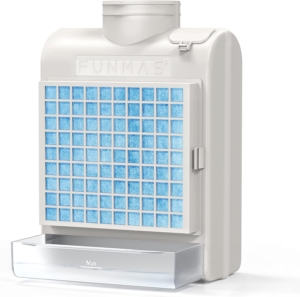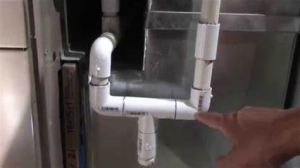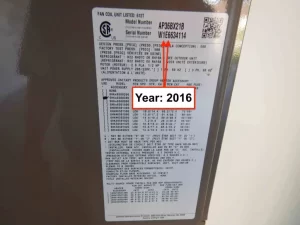A Comprehensive Guide to Condensation Pumps:
Working, Applications, and Benefits

When it comes to the long-lasting performance of your HVAC system, a condensation pump plays are vital. This small piece of equipment is a powerhouse, removing excess moisture and helping your system run efficiently. Without a condensation pump, moisture can build up, leading to water damage or mold growth. But how does it work? And why is it so important? This post will delve into the intricacies of the condensation pump, shedding light on its function and significance in any HVAC system.
What is a Condensation Pump?
In the world of HVAC systems, condensation is a common occurrence. As warm air is cooled down, it loses its ability to hold moisture, resulting in the formation of water droplets. These droplets can accumulate and cause problems if not properly managed. That’s where a condensation pump comes in.
How Does a Condensation Pump Work?
A condensation pump, also known as a condensate pump, is a device designed to remove excess water from HVAC systems. It is typically used in situations where gravity drainage is not possible due to the location of the unit or the distance to the nearest drain.
The pump operates on a simple principle: when water accumulates in the condensate pan, a float switch is activated, signaling the pump to start working. The pump then draws the water from the pan and pushes it through a discharge pipe, usually connected to a drain or an outside location away from the building.
Why Is a Condensation Pump Necessary?
Now you might be wondering, why not just let the water drain out naturally? Well, in some cases, gravity drainage is not an option. HVAC units located in basements, crawl spaces, or other areas below ground level require a condensation pump to move the water upward and away from the unit.
Additionally, HVAC systems with long horizontal runs or those located far from a drain also benefit from condensation pumps. These pumps provide a reliable and efficient solution for removing the collected water and preventing potential damage to the system.
Benefits of Using a Condensation Pump
- Efficient Water Removal: Condensation pumps are specifically designed to effectively remove water from HVAC systems, preventing overflow and potential water damage.
- Versatile Installation Options: Unlike gravity drainage, which depends on the unit’s location, condensation pumps can be installed anywhere, allowing for greater flexibility in HVAC system design.
- Space-Saving: By eliminating the need for a gravity drain, condensation pumps help save valuable space, especially in tight or confined areas.
- Improved System Performance: By ensuring proper drainage, condensation pumps help maintain the efficiency and performance of HVAC systems, leading to reduced energy consumption and lower utility bills.
How Does a Condensation Pump Work?
Have you ever wondered how a condensation pump works? In this section, we will explore the basic components of a condensation pump and the pumping mechanism that allows it to efficiently remove excess water from your HVAC system. Understanding how a condensation pump functions will give you a clearer picture of how it contributes to the overall efficiency of your system.
Basic Components of a Condensation Pump
A condensation pump is an important component of an HVAC system, particularly in situations where the drainage of condensate is required. Let’s delve into the basic components that make up a condensation pump:
- Reservoir: The reservoir is where the condensate from your HVAC system collects. It is usually a small, sealed container that can hold a specific amount of water.
- Float Switch: The float switch is a sensor that detects the water level in the reservoir. When the water level rises to a certain point, the float switch activates the pump.
- Pump: The pump is responsible for moving the accumulated condensate out of the reservoir and away from your HVAC system. It uses a motor and impeller to create pressure and force the water to flow through a discharge pipe.
- Discharge Pipe: The discharge pipe is connected to the pump and serves as a conduit for the expelled condensate. It directs the water away from your HVAC system and usually leads to a suitable drainage location, such as a sink or outside.
Pumping Mechanism of a Condensation Pump
Now that we understand the basic components, let’s take a closer look at how a condensation pump actually works to remove excess water:
- Activation: When the float switch detects a high water level in the reservoir, it sends a signal to the pump to start operating. This ensures that the pump only activates when there is a sufficient amount of condensate to be removed.
- Impeller Action: As the pump is activated, the motor drives the impeller to rotate rapidly. The impeller blades generate centrifugal force, which creates a low-pressure area at the center of the impeller.
- Suction: The low-pressure area within the impeller draws in the condensate from the reservoir through an inlet. This suction effect allows the water to enter the pump and prepares it for the next stage of the pumping process.
- Discharge: Once the water is inside the pump, the impeller’s rotation builds pressure, forcing the condensate to move towards the discharge pipe. The water is pushed out of the pump and flows through the discharge pipe, away from your HVAC system.
Common Applications of Condensation Pumps
Condensation pumps are essential devices in several applications. From HVAC systems to dehumidifiers and high-efficiency furnaces, these pumps ensure efficient removal of excess moisture. In this section, we will explore the common applications of condensation pumps and how they contribute to the overall functionality of these systems.
HVAC Systems
Heating, ventilation, and air conditioning (HVAC) systems are widely used to maintain a comfortable environment in residential, commercial, and industrial buildings. These systems work by regulating temperature and humidity levels. Condensation pumps are integral components of HVAC systems, responsible for removing excess moisture generated during the cooling process.
As the HVAC system cools the air, moisture in the form of condensation collects on the coil surfaces. Without a condensation pump, this excess moisture can lead to issues such as mold growth, water damage, and reduced efficiency. By effectively draining the condensate, condensation pumps prevent these problems and ensure optimal performance of the HVAC system.
Dehumidifiers
Dehumidifiers are appliances designed to reduce the humidity levels in indoor spaces. They are particularly useful in high-humidity regions or areas prone to moisture buildup, such as basements, bathrooms, and laundry rooms. Condensation pumps are commonly employed in dehumidifiers to remove the collected moisture efficiently.
When the dehumidifier extracts moisture from the air, it condenses into water droplets. The condensation pump then pumps this water out of the dehumidifier, allowing for continuous operation without the need for manual emptying of the collection tank. This automated drainage system provided by the condensation pump ensures hassle-free dehumidification and helps to maintain a comfortable and healthy indoor environment.
High-Efficiency Furnaces
High-efficiency furnaces are designed to extract more heat from the fuel they consume, resulting in increased energy efficiency. These furnaces generate condensate as a byproduct, which needs to be efficiently drained to prevent any issues. Condensation pumps are commonly used in high-efficiency furnaces to remove the condensate safely and effectively.
By pumping out the condensate, the condensation pump allows for continuous operation of the furnace without the risk of water damage or performance issues. The condensation pump helps to maintain the furnace’s efficiency by ensuring that the condensate is properly drained, enabling the furnace to operate at its optimal level.
Benefits of Using a Condensation Pump
Condensation pumps are an essential component of HVAC systems that provide numerous benefits for both residential and commercial spaces. In this section, we will explore the advantages of using a condensation pump, including preventing water damage, improving indoor air quality, and enhancing energy efficiency.
Preventing Water Damage
One of the primary benefits of using a condensation pump is its ability to prevent water damage. HVAC systems produce condensation as they cool the air, and if this moisture is not properly drained, it can lead to significant issues such as mold growth, structural damage, and costly repairs. A condensation pump efficiently collects and pumps out the excess water, ensuring that it is safely removed from your property. By effectively managing condensation, these pumps help maintain a dry and safe environment, protecting your property from potential water-related hazards.
Improving Indoor Air Quality
Indoor air quality is an aspect of any living or working space. Poor air quality can lead to various health problems, including allergies, respiratory issues, and even long-term health complications. Condensation pumps play a vital role in improving indoor air quality by preventing excessive humidity. When moisture accumulates in the air, it creates an ideal breeding ground for mold, mildew, and bacteria. These harmful substances can then circulate through the air, compromising the health of occupants. By efficiently removing excess moisture, condensation pumps help maintain optimal humidity levels, minimizing the risk of mold growth and ensuring cleaner, healthier air for everyone.
Energy Efficiency
Energy efficiency is a growing concern for both environmental and economic reasons. HVAC systems that incorporate condensation pumps offer significant energy-saving benefits. By effectively draining condensate, these pumps prevent the accumulation of moisture within the system, reducing the workload on the air conditioning unit. As a result, the HVAC system operates more efficiently, consuming less energy to cool the air. This improved energy efficiency not only lowers utility bills but also reduces greenhouse gas emissions, contributing to a more sustainable future.
In conclusion, condensation pumps offer several advantages that make them an essential component of HVAC systems. They help prevent water damage, improve indoor air quality, and enhance energy efficiency. By efficiently managing condensation, these pumps ensure a safe and healthy environment while also reducing energy consumption. Investing in a condensation pump is a wise choice for anyone looking to protect their property, promote better air quality, and contribute to a greener planet.
Factors to Consider When Choosing a Condensation Pump
When it comes to choosing a condensation pump, there are several factors that you should take into consideration. These factors will ensure that you select the right pump for your specific needs and maximize its performance and efficiency. In this section, we will discuss three factors to consider: pump capacity, noise level, and installation requirements.
Pump Capacity
The pump capacity is an essential consideration when choosing a condensation pump. It refers to the amount of condensate that the pump can effectively handle. The capacity of a pump is typically measured in gallons per hour (GPH) or liters per hour (LPH).
To determine the appropriate pump capacity for your needs, you should consider the amount of condensation your equipment produces. If you have a high condensate production rate, you will require a pump with a higher capacity. On the other hand, if your equipment produces minimal condensation, a pump with a lower capacity may be sufficient.
Noise Level
Another important factor to consider when selecting a condensation pump is the noise level it produces. Nobody wants a pump that disrupts their peace and quiet.
Look for pumps that are specifically designed to operate quietly. These pumps often feature noise-reducing technologies and insulation materials that dampen sound. Additionally, consider the location where the pump will be installed. If it’s in a space where noise may be an issue, such as a bedroom or living area, opt for a pump with a lower decibel rating.
Installation Requirements
The installation requirements of a condensation pump can vary depending on the model and manufacturer. Understand these requirements to ensure a smooth and successful installation process.
Some pumps may require specific plumbing connections or electrical wiring. Make sure the pump you choose is compatible with your existing setup or be prepared to make the necessary modifications. Additionally, consider the space available for installation. Some pumps may be more compact and easier to fit into tight spaces, while others may require more room.
By considering the pump capacity, noise level, and installation requirements, you can make an informed decision when choosing a condensation pump. Remember to assess your specific needs and preferences to find the pump that best suits your situation. In the next section, we will explore the importance of regular maintenance for condensation pumps.
Maintenance Tips for Condensation Pumps
Condensation pumps help maintain the efficiency and functionality of HVAC systems. To ensure that your condensation pump continues to work optimally, regular maintenance is essential. In this section, we will discuss some important maintenance tips that will help you keep your condensation pump in excellent condition.
Regular Cleaning
Regular cleaning is one of the most important maintenance tasks for a condensation pump. Over time, dust, debris, and other particles can accumulate inside the pump, affecting its performance. To clean the pump, start by disconnecting the power supply. Then, using a soft cloth or brush, gently remove any visible dirt from the exterior of the pump. Next, remove the pump cover and carefully clean the inside using a mild detergent and water. Make sure to remove any clogs or obstructions that may be hindering the pump’s operation. Finally, reassemble the pump and restore the power supply.
Checking for Blockages
Blockages can significantly impact the functionality of a condensation pump. It is important to regularly inspect the pump and its drainage line for any blockages. Begin by disconnecting the power supply and removing the pump cover. Inspect the drainage line for any visible obstructions such as dirt, debris, or algae buildup. If you notice any blockages, use a pipe cleaner or a small brush to remove them. Once you have cleared the blockages, reattach the pump cover and restore the power supply.
Ensuring Proper Drainage
Proper drainage is vital for the effective operation of a condensation pump. Without proper drainage, water can accumulate and cause damage to the pump or surrounding areas. To ensure proper drainage, start by inspecting the drainage line for any kinks or bends that may hinder the flow of water. Straighten any kinks and ensure that the drainage line is properly aligned. Additionally, make sure that the pump is positioned correctly, with the outlet pointing downward to allow for smooth water flow. Regularly check the drainage line for any signs of leakage or improper drainage and take prompt action if any issues are detected.
By following these maintenance tips, you can extend the lifespan of your condensation pump and prevent costly repairs. Regular cleaning, blockage checking, and proper drainage will help keep your condensation pump running smoothly and efficiently. Remember, a well-maintained pump is key to a well-functioning HVAC system.
Conclusion
In conclusion, a condensation pump is a valuable component in HVAC systems that helps to efficiently remove excess moisture from the air conditioning unit. By effectively collecting and pumping out condensate, it prevents water damage and ensures optimal performance of the system. Regular maintenance and inspection of the condensation pump help avoid potential issues and ensure its proper functioning. Additionally, installing a high-quality condensation pump can enhance the overall energy efficiency of the HVAC system, leading to cost savings in the long run. Homeowners can enjoy a comfortable and well-regulated indoor environment by understanding the importance of a condensation pump and taking the necessary steps to keep it in good condition.






